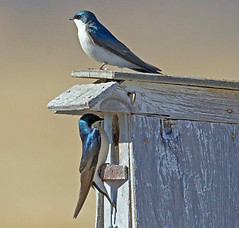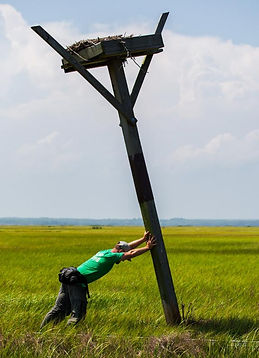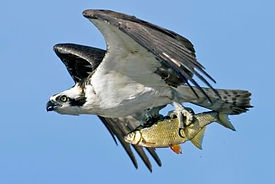
Action: Enhance and Restore Wildlife Habitats
Within our municipal boundaries many animal and bird species compete with us for habitat. We can help these species to find ideal habitat by using enhancement techniques and structures such as Nest boxes, nesting platforms, and bird blinds. If you are interested in any of the projects below contact us for more information.
Click the buttons below to check out the resources on this page for inspiration for your next stewardship project!

Nesting Boxes
Installing nest boxes in or around wetlands gives nesting birds a helping hand when natural nests and cavities such as holes in trees made by woodpeckers, disease or lightning, are scarce. These shelters need to be installed and placed correctly to increase the success of nest box usage.

Waterfowl Nest Boxes
Common Goldeneye,
(Image DUC)
Cavity nesting ducks such as Common Goldeneye and Common Merganser, in the absence of natural cavities, will use constructed nest boxes. Follow the instructions below for installing a waterfowl nest box in a wetland near you.
-
Organize a nest box building or installation workshop in your community. Contact us for information on sourcing supplies.
-
Place your boxes as recommended in the Nest Box Guide for Waterfowl
-
Fill out the online nest box placement form
-
Perform annual maintenance & inspection as described in the Nest Box Guide for Waterfowl
Tree Swallows are a typical bird species seen across the province. Their habitat includes open grassy fields and marshy wetlands. In this habitat they can be seen chasing after flying insects as their primary food source. Tree Swallows will also supplement their insect diet with berries and sweet gale shrubs. They nest in tree cavities and will take up residence in nest boxes.
On the Avalon Peninsula Swallow boxes are preferred over Waterfowl nest boxes due to the low occurrence of breeding pairs of Cavity Nesting Ducks. Consider hosting a swallow box building workshop in your community!
Tree Swallow Boxes
Image from The Telegram

1st CBS Cubs Group (SAM Image)
Resources
DUC Nest Box Maintenance Program
DUC Nest Box Building Plans (PDF)
Nest Box Guide for Waterfowl (PDF)
Nest Box Dimension and Placement (PDF)
Tree Swallow Box Building Plans (PDF)
Thinking outside the (nest) box - Cornell Lab Nest Watch STEM-based
Guide getting GPS coordinates from your Smartphone!
Waterfowl Monitoring Project Protocol Data Sheet (EHJV) (PDF)
Contact Us if you'd like to host a nest box
building event in your community!
Artificial Nesting Structures
Many wildlife species, do not use nesting boxes. Instead they rely on land-based nesting or raised platforms. Many species benefit from the construction of artificial nesting structures such as artificial islands (great for several species of terns and waterfowl) or nesting platform poles (great for predacious birds like osprey).
Image from The Western Producer
Artificial Floating Islands
Many bird species in wetlands nest and loaf on islands due to the reduced risk of predation from land-based predators. These species benefit from the construction of artificial islands. Typically these structures can be constructed of wooden cribs (e.g. Tamarack / Larch), measuring approximately 4 square meters that have been filled with rock and soil.
The islands must be positioned so that they are higher than the highest water mark. Hardy shrubs and herbaceous plants (e.g. alder, willow) must be planted on the islands to provide cover and to prevent occupancy from gulls. Take care to prevent the use of toxic construction materials (e.g. treated wood, contaminated soils) and disturbance to plant and animal communities.
Other forms of artificial islands involve planting native marine plant species into landscaping fabric, which is then fixed to floating structures made of plastic piping or empty gabion baskets (metal mesh cages). This type of floating island requires careful placement in areas that do not have widely fluctuating salinity levels and require placement such that disturbance would be minimal when roots are establishing. Floating islands may be beneficial in terms of oxygenating the water column, as algal blooms would not smother the highly perched plants. The floating plants should, ideally, continue photosynthesizing despite the presence of algae, and may be of benefit in absorbing excess nutrients to deter algae growth. Annual removal and re-installation of islands may be necessary in response to ice conditions in tidal areas.
Resources
Increasing Waterfowl Nesting Success on Islands and Peninsulas - US Fish and Wildlife (PDF)
Floating Island Construction for Caspian Tern - Bird Research Northwest
Artificial Nesting Platforms
Image from New Jersey Osprey Project
Quite a number of osprey artificial nest designs have been developed for different habitats and sites. It is important to first asses your potential site/municipality. Osprey platforms work best in areas where there are a limited number of large trees for nesting, and are near a large body of water so the Osprey is able to fish. For more information about preferred Osprey nesting sites contact SAM.
Image from Wintu Audubon Society
Image from Cornell Lab of Ornithology
A platform may be mounted on a single pole (i.e. untreated telephone pole) at least five meters above the ground. All nail and bolt holes are pre-drilled to prevent splitting. The wire mesh is nailed in the platform. Steel braces are bolted to the platform and the lag screws are used to secure the platform to the pole. Some sticks should be wired to the nest to help stimulate nest building. The use of tamarack larch or cedar is highly recommended.
Nesting structures should be placed within fifty (50) meters of water and at least one hundred meters from the nearest residence. Regular inspection of the structure is necessary. After a few years some nests become quite large because the osprey continually adds new sticks. This weight may cause support structures to break. If the nest does become large, it is often a good idea to remove some nest material outside of the breeding season. With proper construction and maintenance, the nest structure may last up to fifteen to twenty years. It is not uncommon for several years to go by without osprey use of the artificial structure. Only an osprey can ever truly know what an osprey seeks during placement of nesting structures!
Osprey Platform Resources
New Jersey Osprey Project - Conserve Wildlife
Build an Osprey Platform - Conserve Wildlife New Jersey (PDF)
2017 Osprey Project in New Jersey - Report (PDF)
Photography Blinds, Viewing Decks and Towers
Adults often enjoy using bird watching towers or blinds; these can be fun community building projects or completed with the help of a Green Team, committee, or volunteers. Corduroy Brook Enhancement Association in the Town of Grand Falls-Windsor has experience with these kinds of projects and would be a good contact.
Viewing Deck in Winterland, NL (SAM Image)
Viewing Tower in Sackville, NB (SAM Image)
Photography Blind in Lewisporte, NL (SAM Image)
Photography Blind in Grand Falls-windsor, NL (SAM Image)
There are many different styles of wildlife/bird viewing structures. It is important to keep the comfortable and accessible for everyone. Use different heights for viewing through blind walls, keep railings at a safe height for viewing towers, and keep disturbance to the environment at a minimum during construction.
Construction Resources
Restoring Habitat Resources
SAM Planting Guide for Ecological Restoration
The Atlantic Salmon Conservation Foundation - Salmon Hub
Department of Natural Resources: Geoscience Resources of NL
Wet-Pro Certification: Water Quality Monitoring Course for Volunteers
An Introduction and User's Guide to Wetland Restoration, Creation, and Enhancement
Department of Municipal and Intergovernmental Affairs: Areas Subject to Federal-Provincial Flood Risk Mapping
Many habitats in urban areas suffer from degradation and sometimes even loss. Restoration techniques have been developed to rehabilitate degraded habitat and to return some or all of the original ecosystem functions.
If you have any questions and are interested in pursuing a habitat restoration project in your community, please contact us.












